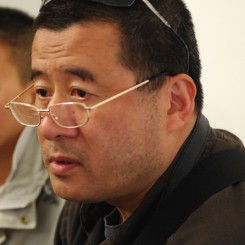Known as the “father of video art” in China, Zhang Peili has been at the forefront of contemporary Chinese art since 1988, when he created what is popular credited as the first piece of video art in the People’s Republic. Currently, he is also the Director of the New Media Art Centre at the renowned China Academy of Art in Hangzhou, which is shaping the next generation of artists working in video and mixed media.
Speaking prior to the opening of this career retrospective at Shanghai’s Minsheng Art Museum, Zhang reflected on the current state of Chinese art, education, Ai Weiwei and his latest video installation.
How does it make you feel for you to look back at the different stages of your career with this retrospective?
I’m not a person who sticks to rules, and I’m never satisfied. I always have questions for people’s common knowledge and I always hold a doubtful attitude. In retrospect, I’m not the kind of person who always takes risks, but I do get some pleasure from risk. I think at some level I always make mistakes in the process of my work and take risks.
Do you have a favorite stage of your career and a favorite piece of work?
After a long time thinking about the pieces, I am satisfied with this exhibition and they are all my children; it’s hard to decide which one is my favorite. Maybe the latest one on some level, because it’s fresh and I’m very passionate about it. The prime of my career, in my opinion, was 1996, when I’d just come back from the US. I’d spent 10 months in the United States from 1994 to 1995. I couldn’t do anything at that time. I was a little depressed, but when I came back from 1996 to 1997 I did a lot of work and picked up the pieces.
Video-making is very popular among young people. Do you feel like a pioneer?
I started to make video earlier than other people and I have made it longer than other people. It’s dangerous to be a pioneer or example to others. I hope everyone treats me like a goal, so that they can also achieve this goal.
You’re not only an artist, but also an educator. What do you try and teach your students?
I try my best to inform my students not to pursue one truth or knowledge because there is more than one truth. In the 1950s we were taught there was only one truth. That’s a reality in revolution but today you have the right to be doubtful about any knowledge before accepting it. That’s why I don’t want my students’ work to have any similarity to mine; if it’s obviously like my work I don’t feel comfortable about it.
How would you describe the direction you’ve been moving towards with your latest works?
I don’t want to make a clearly expressed idea but an uncertain language of ideas, like something’s there, but it’s not there. My personal opinion is that I don’t want to use my work to educate anyone and I don’t want to use artwork as a tool for political or philosophical reasons to express my political or philosophical opinion. I’m more focused on the emotional influence the work can bring to people. The visual, spatial and audio impact can all be obvious components, but emotional things are harder to pin down.
Tell us a little about the new work in the exhibition?
There’s one piece in the exhibition that is new. It’s an airbag made to a special width, height and depth and I used several air machines—three of them—to blow it up, and the airbag it blows up so big that the audience is pushed to the corners of the room and then it shrinks to a very small space at a very fast speed. So when the airbag blows up and expands, the light is getting stronger and the light is sharpest when the airbag is biggest.
As someone who has been on the scene for such a long time, do you have an opinion on Chinese contemporary art’s position internationally?
The reality I know is quite the opposite of the auction market. In Western countries a famous artist is first recognized in the academic world and then step-by-step becomes successful in the commercial world. But in China, for some complicated reasons, the situation is the opposite. Chinese artists who have great influence internationally, it’s all because of political reasons and not because of art. As long as the work contains Chinese elements or expresses political opinion in an obvious way, or expresses an opinion on society and culture, they think that represents China and that’s it. In Western art history artists traditionally contribute ideas to the art world, but nowadays it’s hard to say that Chinese artists are contributing in that field.
Given your own reluctance to use art as a political tool in recent years, how do you feel about Ai Weiwei?
I respect Ai Weiwei a lot, but people like him are getting a lot of attention in Western countries. I understand the attention, but if it means that Western critics hope that every artist in China is like him or should be like him, I think that’s terrible. He is not a measuring stick; no one person can be the representative for a society.
Do you think that all artists should have a sense of responsibility?
That is a decision each artist has to make. What I care about the most is whether or not the expression is meaningful. I hope the criticism or opinion of Ai Weiwei can focus more on whether his artistic language or ideas are meaningful.
All photos courtesy of Zhang Peili.







